This primer will illustrate and explain some terms and concepts from my talks on futureprimitive.org, "Destiny in the Stars". JLL
Chapter 2: Astrology Without Stars
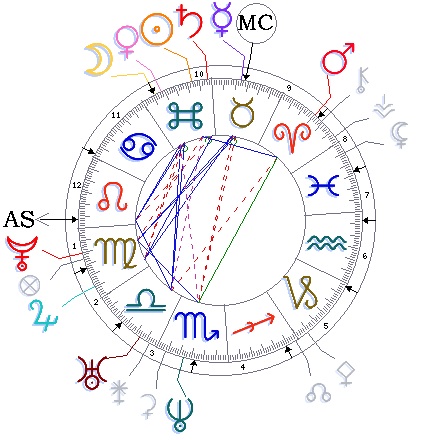
Primer 2 - ILLUSTRATION 1: Typical Horoscope
Horoscopes come in many variations and formats. The word derives from horos, "the hour," and skopein, "to observe." By definition, the horoscope is the observation of the heavens at the hour of birth, or the result of such an observation -- but it isn't, not really. In reality, a horoscope is a geometric matrix for mapping the positions of the sun, moon, and planets at the moment of birth. Nothing, not a single sight or feature in the real-sky environment has to be observed. The ascendent (AS), which is the sign rising on the eastern horizon at the moment of birth, is carefully noted from tables, but not actually observed. Even if an astrologer today were to preside at the birth of a child, he or she would not observe anything in the skies at that moment. Rather, the astrologer would consult tables to construct the horoscope (old-fashioned method), or feed the birth data into a computer and print out the result. (Sample horoscope from http://www.astrotheme.fr/)
The example above displays all the typical elements of a horoscope:
• the symbols or glyphs of the 12 astrological signs (tropical zodiac)
• the wheel of the signs: 12 equal 30-degree divisions, calibrated
• the symbols of the planets, distributed through the signs
• the ascendent AS and midheaven MC, eastern horizon and point overhead
• the format of the houses, 12 uneven sectors marked around the rim
• the aspects or angular relations between planets, shown by colored lines
• other features such as the lunar nodes, Chiron, asteroids, Arabian parts
In this example, the sun (a circle with dot at the center) stands in 8 degrees of Gemini in the 10th house, the ascendent (rising sign) is in 26 Leo, and the moon is in 25 degrees of Gemini in the 10th house. The house-system is unequal, so there are oddities in the house/sign overlay. For instance, the 2nd house has 27 degrees of Libra stretched across it, but the 3rd house has the 3 remaining degrees of Libra, all 30 degrees of Scorpio in it, and the first 5 degrees of Sagittarius as well -- a total of 38 degrees. Because the 3rd house comprises 38 degrees, some other house must shrink by 8 degrees. Astrologers make much talk of these irregularities in the house/sign overlay, but the distortions are simply due the space-formatting system they have adopted. It is as if I analyzed your character and moods from your contorted reflection in a funny house mirror. More on this problem of space distortion at the end of this chapter, when I present my solution, the terrascope.
Obviously, a horoscope is a complex construction loaded with thousands of bytes of information, all subject to interpretation and synthesis according to the competence of the astrologer. It's almost unimaginable what the horoscope contains in the full array of permutations of signs, houses, aspects, and so on... But one thing is perfectly clear: there is not a star in sight. (Except the sun, the central star of our solar system). The sign Gemini is the "sun sign" of the native, yes. But Gemini in the tropical zodiac does not indicate the star pattern of the Twins. It says nothing about where any of the planets stand in the real-sky perspective. In reality, this person born with the sun in 8 degrees of Gemini has the sun in conjunction with Aldebaran, the star that marks the eye of the constellation of the Bull. No tropical astrologer would inform the client of this fact, not from deceit but from omission: astrologers don't know anything about the stars.
Astrological Pizza
So, gaze and gander long and hard, you will not find one single feature or clue that depicts or represents the starry skies in a horoscope of the tropical format. Originally, of course, all astrology was observational and night-bound. What happened long ago was that Ptolemy reformatted the ancient observational science into a computational science that uses the orbital plane of the earth without reference to the celestial environment.
The astrological signs shown in ILL 1 belong to the tropical framework codified around 150 CE in Ptolemy's classic book, Tetrabiblos. In chapter 12, "The Annual Seasons," he magisterially stated the rule that established the precedence of the starless signs over the true-sky constellations:
The beginning of the whole zodiacal circle -- which in its nature as a circle can have no beginning, nor end, capable of being determined -- is therefore assumed to be the sign of Aries, which commences at the Vernal Equinox... (In Chapter 25, "The Places and Degrees of Every Planet," he continues:) The beginnings of the signs, and likewise those of the terms, are to be taken from the equinoctial and tropical points. This rule is not only clearly stated by writers on the subject, but is also especially evident by the demonstration constantly afforded, that their natures, influences and familiarities have no other origin than from the tropics and the equinoxes." (My emphasis)
So there you have it. To visualize what Ptolemy did, look at ILL 2, presenting a god's eye view of the ecliptic plane of the earth:
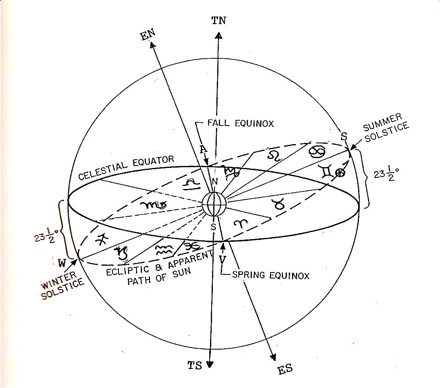
Primer 2 - ILLUSTRATION 2: Ecliptic Model
In the geocentric perspective, the earth occupies the center of a huge circular plane with the sun rotating around it annually (counterclockwise, as seen here) in the order of the seasons. This circular plane tilts at an angle of 23 1/2 degrees to the imaginary plane of the celestial equator, that is, the equatorial band of the earth projected into space. Six months out of the year, from March 22 to Sept 22 (Aries to Virgo), the sun is above the celestial equator. Six months of the year, from September 23 to March 21 (Libra to Pisces) the sun is below the celestial equator. Hence the seasons are produced by the tilting intersection of these two massive planes.
Now the apparent path of the sun, the true orbital track of the earth, can be conceived as a perfect circle of 360 degrees. Divide it pizza-like into twelve equal 30-degree sectors and you have the 12 starless signs of the tropical zodiac. By Ptolemy's rule, the sign sequence begins at V, the vernal point, where the sun passes from south of the celestial equator to north: this occurs on March 21 each year, the vernal or spring equinox. On the ecliptic scale this point is called "zero Aries," and the signs proceed from there: Aries, Taurus, Gemini, and so on. Astronomers disregard the astrological terms and use numerical notation for the signs: astronomically, the sign Gemini is 60 - 90 ECL, ecliptic longitude. The sign Cancer is 90 - 120 ECL, etc. The position 14 Virgo in the astrological format is 164 ECL, astronomically speaking. And so on.
So, the mapping of the horoscope uses the pizza-slice model of the ecliptic plane with no reference to the surrounding heavens. The planets between earth and sun (mercury and venus), the moon, and the planets beyond the earth's orbit (mars, jupiter, saturn, uranus, neptune, pluto) are all mapped relative to the astrological pizza. This is how a horoscope is constructed.
Stars and Genes
Living in Hollywood in 1976, I was deep into the investigation of the constellations, and, at the same time, I was practicing tropical astrology without stars! How's that for cosmic hypocrisy? I was conflicted about this matter, believe me, but I was determined to bring the two formats together and somehow reintegrate the real-sky perspective into astrology.
Basically, I had two daunting problems to solve. The first concerned how to map the night sky in a format that suited my purposes inworking with a round horoscopic format. It was not difficult to find picures of the constellations and sky maps. I found numerous sky atlases in the Hollywood public library on North Cahuenga (right across from Plato's Cave, a notorious orgy club, and up the street from the Happy Beaver Strip Joint, as I recall). I also found books on the history of stellar cartography, showing how the constellations had been pictured graphically in different cultures through the ages. At the Rudolf Steiner Library on Vermont Avenue, not far from to an all-night restaurant where Castaneda sometimes hung out, the librarian gave me their reserved copy of Star Names - Their Lore and Meaning by Richard Hinkley Allen. Published in 1899, and still in print, it is the single complete text on the mythography and nomenclature of the constellations, all 88 of them.
My efforts were hugely advanced by the appearance in 1977 of Astrophysical Directions by Michael Erlewine. Here was a book, unique in its time and still unique today, providing extensive astronomical data for astrologers. (My eternal thanks to the genial Ray Mardyks for pointing me to this book.) Erlewine provided a two-page layout of the entire panorama of the ecliptic zodiac: the northern constellations, from the Fishes to the Lion (here below), and the soutern constellations, from the Virgin to the Watercarrier (not shown).
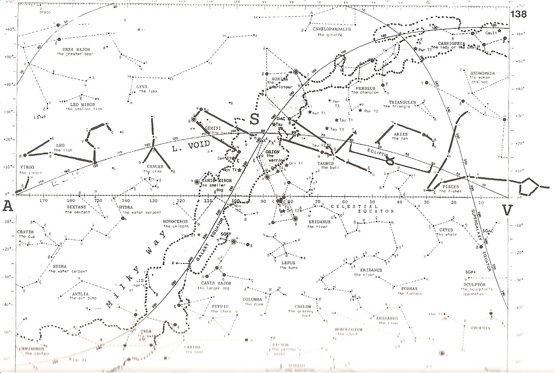
Prinmer 2 - ILLUSTRATION 3: Northern Ecliptic Constellations
I have added the signatures for the six constellations, right to left: Fishes, Ram, Bull, Twins, Crab, Lion. The straight line is the celestial equator. Observe how it runs through the belt of Orion, a massive prominent extra-ecliptic pattern, perhaps the best-known constellation in the world. The section bounded by dotted lines is the Milky Way. Erlewine added a median line within the galactic band, the galactic equator, but this is theoretical, for the Milky Way is wavy and irregular. The Milky Way crosses the ecliptic zone at the Bull and the Twins. Notice how the long horns of the Bull extend into the Milky Way, and the Twins have their feet in it, up to their knees. (In the previous lesson, we noted that the Milky Way intersects the ecliptic constellations toward the south at the Scorpion, Snaketamer, and Archer.)
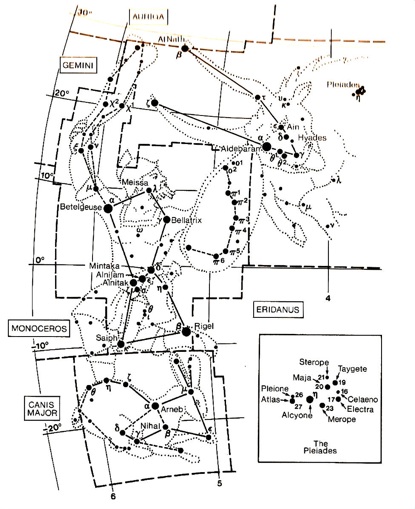
Primer 3 - ILLUSTRATION 4 : Orion the Hunter with Bull
In most representations, Orion the Hunter is interactive with the Bull (Staal, The New Patterns in the Sky). The upraised right arm of Orion extends into the Milky Way, so that he appears to be hanging off it, dangling, or perhaps waving goodbye. In fact, when we look in the direction of Orion, we are gazing down the spiral arm where the solar system is located, toward the end where the spiral dissolves due to the pinwheel motion of the galaxy, like droplets dispersing from a rotating lawn sprinkler. In that direction, we are looking into the cosmic past, and there is Orion, waving goodbye as we drift into the future. The direction toward the cosmic future is signified by another extra-ecliptic constellation, the Swan, Cygnus: it shows the trajectory of the solar system forward through the galactic arm, returning to Source. These are striking details that come up time and time again in real-sky observation when you combine star lore with the latest state-of-the-art astronomical data on the structure of our galaxy.
In ILL 3, the curving arch calibrated in 10-degree units is the ecliptic, of course. V is the vernal point of 1 degree Aries, the beginning of the ecliptic scale. Signs are sections on that scale, without reference to the background stars. I have designated the sign Taurus, 30 - 60 ECL longitude, by a large bracket with the astrological symbol of a circle and horns. That 30-degree section of the ecliptic is the starless sign. It is nothing but a geometrical sector, a mapping feature that cannot be observed, any more than you can observe the time zones when you fly across the USA. Yet that mapping feature determines the sun signs and personality traits in tropical astrology. Figure it.
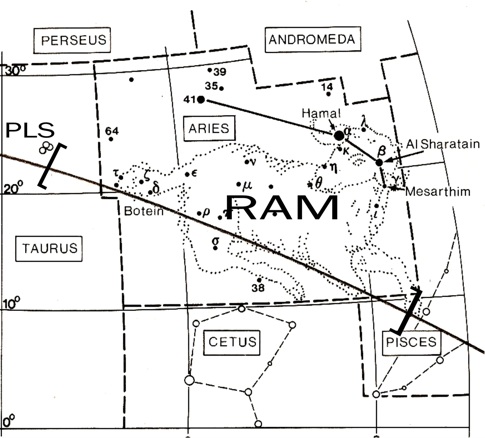
Primer 3 - ILLUSTRATION 5: Ram with the Sign Taurus
Another figure from Staal shows the composite of the Ram in greater detail. (Staal does not extend the signature down to delta Arietis, Botein, to give the L-shape.) Almost all the constituent stars are above the ecliptic. The section of the ecliptic plane between the two brackets is the astrological sign Taurus. It is not equivalent to the Ram, because sign and constellation do not "corrrespond" -- I cannot overstress this point. Signs and constellations are juxtaposed in a spatiotemporal framework, that's all.
The clustered stars on the extreme left, just beyond the bracket, are the Pleiades (PLS), the Seven Sisters, a brilliant open cluster of young blue stars recognized in sky lore all around the world. They are situated on the back of the Bull. The longitude of the Pleiades is ECL 60, or 1 degree Gemini in the astrological signs.
The Ram is dim and occupies only 24 degrees in extent on the ecliptic. To the right of the Ram, the Fishes present a large V. The Fish bordering on the Ram leaps up and away from the ecliptic ("outbounding") toward the constellation of Andromeda, the Fallen Woman. The Andromeda myth is a Greek version of the Gnostic myth of the Fallen Sophia—the single most important directive myth for our species. This graphic detail is another example of interaction between the ecliptic and extra-ecliptic constellations.
I have suggested that the Fishes be pictured as whales. The outbounding Fish looks like a great grey whale leaping from the ocean, as seen in many nature films.
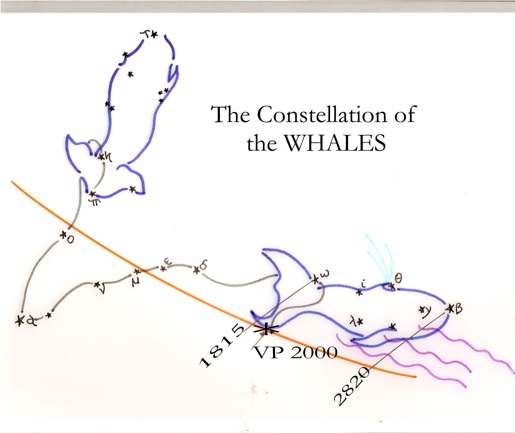
Primer 3 - ILLUSTRATION 6: The Whales ( © JLL, 1983)
The ochre line is the ecliptic. The VP or vernal point where the ecliptic scale begins (as determined by Ptolemy and others) currently sits at the asterisk, right under the tail fin of the western Whale. Due to precession the entire orbital plate of the earth rotates relative to the surrounding stars. In other words, the spring equinox (VP) occurs in different ages against the background of different constellations. This shift determines the zodiacal ages or World Ages. The VP shifts on the ecliptic left to right, opposite the movement of the sun, moon, and planets. About 2000 years ago, it moved from the Ram into the Whales. In 1815 the VP aligned with the star omega (shaped like a w) on the tail of the Whale. This celestial clue suggests that a massive thrust in collective human striving began at that time—the initial push toward globalization, seen in such world-shaping movements as communism, millenarian cults, Darwinian social theory, materialism and positivism, counterbalanced by the Romantic Movement, Transcendentalism, Spiritualism, theosophy, the coming of Buddhism to the West. etc.
Currently, the VP is three degrees further along the ecliptic, touching the lower fin. It will align with the nose star of the Whale, beta, around 2820 CE. It's a long haul to the end of the Piscean Age.
The ecliptic zodiac is a star clock.The timing of the VP transit through the World Ages can be calculated down to a decade or so by using precise star longitudes. The method of tracking historical events with the star clock is called precessional timing. Additional to the astronomical and historical factors involved here, the element of mythopoesis is crucial. To imagine the long-term history of the human species, or phylogenetic learning, requires the use of our imaginative faculties. Gnostics in the Mystery schools taught how to do just that. Through their own shamanic visionary powers, they determined that the goddess Sophia, the living intelligence of the earth, whose body is the earth, Gaia, provided humanity with the luminous epinoia, the power of imagination:
And the luminous epinoia was hidden in Adam [primal humanity], in order that the Archons might not reach that power, but that the epinoia might be a correction to the deficiency of Sophia. (Apocryphon of John, 20.25)
Epinoia is the directive power of imagination, the true saving factor in Gnosis. The Apocryphon of John tells how the Divine Sophia, when she realized the problem that humanity would face with the Archons, invested “the luminous Epinoia” in Zoe, the life force, so that in our biological makeup we would carry an imaginal capacity. This teaching is very close to what Mystery School revivalist Jean Houston says about the role of myth in human experience: "Myths serve as source patterns originating in the ground of our being. While they appear to exist solely in the transpersonal realm, they are the key to our personal and historical existence, the DNA of the human psyche."
If our biological makeup carries the imaginal power of epinoia, as Gnostics taught, then myth is not just figuratively “the DNA of the human psyche,” it is actually deposited in the DNA of the species. For humankind, the power of mythic imagination is profoundly linked to the life force.
-
Not in His Image, Ch 22, "Divine Imagination"
The graphic representation of the Whales displays two mythic themes to contemplate and render in narrative form: the leaping Whale points to Andromeda, the Fallen Woman, a version of the Gnostic Sophia. The western Whale swims into the currents that stream from the Urn of the Waterbearer or Manitou, a spiritual guide for the human species. We may imagine that in some way currents from the future entrain the course of the Whale: that is, they orient the phylogenetic learning of humanity, so that we can advance on what we learn as a species. StarBase shows how the premium assets of phylogenetic learning can be inherited by each of us. It provides a way to access the species-wisdom encoded in human DNA and carried in the genome, not in the selected genetic chromosomes.
From Flat to Round
I spent weeks, months, and years in the study of Erlewine's book, and used it to improve and expand my observation of the night skies. But I could not apply his constellational figures to the horoscope for one nagging reason: the horoscope is round. Erlewine's sky map, like most other sky maps, was in a flat format, a planispheric projection. What I needed was to map the ecliptic constellations in a round format, so that I could situate the star patterns on the perimeter of the horoscope and see both tropical and stellar positions simultaneously. Erlewine provided a long list of star longitudes on the ecliptic, so I was finally able to attack this mapping problem. I started by drawing a circle and marking it into 360 degrees, then inscribing the composite stars of the thirteen ecliptic constellations in their exact positions on the ecliptic scale. Not all the stars were right on the ecliptic rim, of course, so I had to do quite a bit of fiddling to displace them, north or south, taking into account such factors as declination (distance of a star off the ecliptic) and latitude (distance of a star off the celestial equator), in order to keep the model accurate. I did all this mapping by hand, with pencil and compass, going through perhaps fifty versions before I had an accurate circular map of the star zodiac, which I called the Rimsite model.
More on the Rimsite in the next chapter! I have to explain that there was yet another obstacle for me to surmount. Once I worked out a rough version of the "zodiac in the round," I realized that I had a serious problem to solve before I could use it. This one was about those medieval house-systems, the space division formats called Placidian, after Placidus, or after Campanus, Morinus, Koch, and others. As explained above, these space-mapping tools are geometric grids that distort space the way a funny house mirror distorts your face. With an astronomically accurate circular model of the constellations on hand, I could not use any of these systems that did not present equal-house divisions. Otherwise, the location of the planets in the houses could not be projected by line-of-sight into their real-sky locations. What a drag.
Sometime in the summer of 1978, I had a breakthrough. It came when a combination of factors congealed in my mind. The insight dawned after years of reading about non-Euclidean geometry, a subject that I barely understood. But then, fortunately, I discovered the projective geometry of the anthroposophy school, developed by George Adams and Olive Whicher, which treats space as a supple, elastic medium rather than a dead, vacant void. Finally, I combined the methods of projective geometry with the morphological perception of nature applied by Goethe in his studies of the metamorphosis of plants. The result was, not just another house system, but a space-time mandala incorporating morphological principles based on an 8 module, rather than a 12 module: the terrascope.
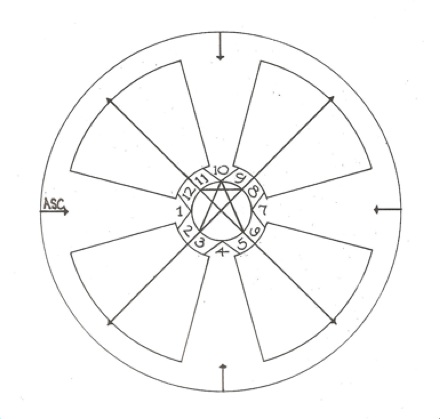
Primer 2 - ILLUSTRATION 7: The Terrascope (© JLL, 1978)
Like the conventional horoscope, the terrascope has twelve houses which I promptly renamed facets. Goodbye to monkish medieval geometry!! The facets are all equal, 30 degrees in extent, so they produce no locational distortion relative to the real-sky environment. The one striking innovation of the terrascope is that it places the ascendent ASC or rising sign in the center of the first facet, or first house, not at the cusp or initial point of it. In setting up a horoscope with this format, the overlay of the wheel of twelve signs runs evenly around the twelve facets. This means that when I came to place the circular star zodiac around the perimeter of the sign-wheel, all the planets in the facets could be projected directly and accurately by line-of-sight into their real-sky positions in the constellations.
That done, I was ready for the culminating step: conversion of the horoscope to Star Base.
Well, almost ready.


